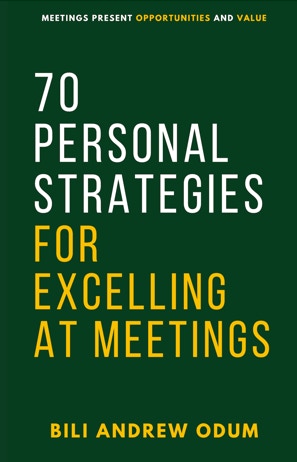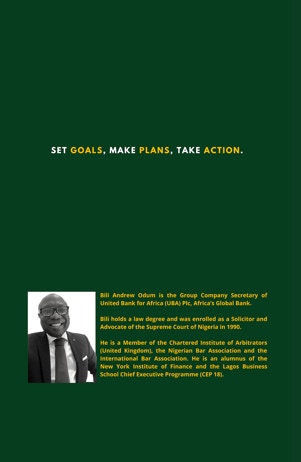
Angela Aneke
Ms. Angela Aneke is a Board Advisor, seasoned Banker and strategic thinker. She is a Non-Executive Director on the Board of United Bank for Africa Plc, where she also serves as the Chairman of the Board Governance Committee.

How to Excel at Meetings by Angela Aneke

In 2010, I wrote the following paragraph in a book titled, “The Power of Vision – Insights on Tony Elumelu”, as my contribution to an Anthology of various articles written by Friends, Associates, Colleagues, and Family on the retirement of Tony O. Elumelu, CON (TOE) as the Chief Executive Officer of United Bank for Africa Plc in July 2010, as a tribute to his success and achievement.
“It is impossible to work directly with TOE without ‘meetings’….Meetings are the platform through which his management-by-consensus style plays out. It is also through meetings that he (TOE) energises the organisation.”1
I have since, under TOE’s tutelage, learned and come to appreciate the value and realise the importance of meetings in building institutions the “TOE Way”, whether it is on a day-to-day basis as part of executive management, or at periodic meetings of the Board of Directors.
So in this contribution, I will pen down what I have learned from this “Maestro of Meetings” and have tried to adopt as my personal strategies, as I have seen them work time and time again.
Let me start by defining Meetings as captured by Wikipedia:
“A meeting is a gathering of two or more people that has been convened for the purpose of achieving a common goal through verbal interaction, such as sharing information or reaching agreement. Meetings may occur face-to-face or such as a telephone conference call, a Skyped conference call or a videoconference.”
So the bottom line for convening a meeting is to achieve a common goal. Results are what differentiate an Effective Leader from an Ineffective leader. So how does one convene and conduct an Effective Meeting in such a way as to achieve Results?
1. Start with an Agenda – Every meeting must have an agenda. A well-crafted agenda will ensure the meeting achieves its desired results. For a Board of Directors Meeting, the agenda is set by the Chairman of the Board, or there is a standard template captured in the Board Charter.
2. Have the goal in mind – what do we want to achieve at the end of a meeting? What is the objective of the meeting? Remember that for meetings to be effective, there must be results.
3. Who should chair the meeting? – The Chairman is a key role in conducting a meeting, be it a management meeting or a meeting of the Board of Directors. I have found this to be a critical role and the effectiveness of this person determines the success or failure of a meeting. Group dynamics play a key role in meetings and the personal attributes (knowledge, competence, interpersonal skills, communication, leadership style, etc) of the Chairman come into play.
4. Who are the participants? – Who should be at the meeting? Recognise that “Ideas can come from anyone.”2 Not only those who have direct involvement in the issues to be discussed necessarily have to be at the meeting. Draw participation from across the organization and across hierarchy.
5. Be Prepared – To contribute to a meeting, whether as a participant or the leader, you need to be prepared for the meeting. This is even more critical if you are on the board of directors of an institution. One cannot overemphasize the importance of the role of the board of directors in institution building. The buck stops with you, so ensure that you have thoroughly reviewed your board pack ahead of the meeting.
6. Draw participation from all participants – invite all participants to contribute to the meeting, especially those that are quiet.
7. Listen – Listen to other participants at the meeting. As the Bible says “Be slow to speak and quick to listen”. This is so important!
8. Debate – Debate issues rigorously. Submit to superior opinions.
9. Write down – pen down your thoughts while the debate is going on so you don’t lose your thoughts, and more importantly, so you articulate your thoughts in a clear manner.
10. Be Flexible - Be flexible on your position and be willing to embrace perspectives of others. But avoid Group Think!
11. Consensus Building – seek to build consensus at the meeting. Consensus is not 100% unanimity.
12. Decision Making – Reach a decision based on the information that has been shared.
13. Own the decision – when the decision is reached, regardless of what your opinion was coming into the meeting, Own It!
14. Minutes and Next Steps – accurately capture the decisions reached and next steps and disseminate to participants. Next steps should state who will do what by when. To ensure execution of the decision reached, assign follow-ups to someone who is execution oriented. Clearly, for a meeting of the Board of Directors, the Company Secretary is that person, who should capture this in the Minutes and Matters Arising.
Over time I have done some research on these learning points and shared my insights at various fora.
Let me conclude with a quote that resonates with me and reflects the benefits of meetings the TOE Way:
“The amount of meetings I’ve been in – People would be shocked. But that’s how you gain experience, how you can gain knowledge, being in meetings and participating. You learn and grow.” – Tiger Woods.
Footnotes
1. Excerpts from, Power of Vision: Insights on Tony O. Elumelu
2. TOE Way – Business Values of Tony O. Elumelu CON
